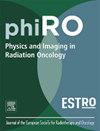质子与光子治疗立体定向心律失常放射消融术治疗室性心动过速的比较
IF 3.3
Q2 ONCOLOGY
引用次数: 0
摘要
背景和目的七室性心动过速(VT)是一种危及生命的心律失常,通常采用导管消融治疗;然而,有些病例仍然难治性。立体定向心律失常放射消融术(STAR)提供了一种无创的替代方法。虽然基于光子的STAR是有效的,但质子治疗可能会改善剂量一致性并避免危险的关键器官(OARs),包括心脏本身。本研究的目的是比较质子和光子治疗VT的剂量-体积指标。材料和方法我们回顾性分析了34例接受光子STAR治疗的VT患者。Proton STAR计划是在商业治疗计划系统中使用稳健优化生成的,以在单个馏分中提供相同处方剂量的25 Gy。提取关键OARs(心、肺、心室)和靶标的剂量-体积指标,包括D99、D95、Dmean和D0.03cm3。采用夏皮罗-威尔克检验评估正态性,采用配对t检验或Wilcoxon符号秩检验进行模式间的统计比较,多重比较采用Bonferroni校正。结果质子和光子计划的目标覆盖率相当,CTV D95分别为25.8 [21.6-28.7]Gy(RBE)和27.2 [21.6-29.3]Gy(p <;0.001)。质子治疗显著降低OAR剂量,包括心脏Dmean(3.6±1.5 Gy(RBE) vs. 5.5±2.0 Gy, p <;0.001)和肺Dmean(0.6[0.0—-1.9]Gy (RBE)和1.2 (0.2 - -2.6)Gy, p & lt;0.001),同时保持最佳的目标覆盖率。结论:与光子治疗VT相比,质子治疗STAR具有显著的OARs保留潜力,同时保持相同的靶覆盖率。这些发现强调了质子治疗改善室速患者预后的潜力。本文章由计算机程序翻译,如有差异,请以英文原文为准。
Comparison of proton and photon therapy in stereotactic arrhythmia radioablation for ventricular tachycardia
Background and Purpose
Ventricular tachycardia (VT) is a life-threatening arrhythmia commonly treated with catheter ablation; however, some cases remain refractory. Stereotactic arrhythmia radioablation (STAR) offers a non-invasive alternative. While photon-based STAR is effective, proton therapy may improve dose conformity and spare critical organs at risk (OARs), including the heart itself. The aim of this study was to compare the dose-volume metrics between proton and photon therapy for VT.
Materials and Methods
We retrospectively analyzed 34 VT patients who received photon STAR. Proton STAR plans were generated using robust optimization in a commercial treatment planning system to deliver the same prescription dose of 25 Gy in a single fraction. Dose-volume metrics, including D99, D95, Dmean, and , were extracted for critical OARs (heart, lungs, cardiac-chambers) and target. Shapiro-Wilk tests were used to assess normality, with paired t-tests or Wilcoxon signed-rank tests for statistical comparisons between modalities, with Bonferroni correction applied for multiple comparisons.
Results
Proton and photon plans achieved comparable target coverage, with CTV D95 of 25.8 [21.6–28.7] Gy(RBE) vs. 27.2 [21.6–29.3] Gy (p < 0.001). Proton therapy significantly reduced OAR doses, including heart Dmean (3.6 ± 1.5 Gy(RBE) vs. 5.5 ± 2.0 Gy, p < 0.001) and lungs Dmean (0.6 [0.0–1.9] Gy(RBE) vs. 1.2 [0.2–2.6] Gy, p < 0.001), while maintaining optimal target coverage.
Conclusion
Proton therapy for STAR demonstrated significant potential for OARs sparing compared to photon therapy for VT, while maintaining equivalent target coverage. These findings highlight the potential of proton therapy to improve outcomes for VT patients.
求助全文
通过发布文献求助,成功后即可免费获取论文全文。
去求助
来源期刊

Physics and Imaging in Radiation Oncology
Physics and Astronomy-Radiation
CiteScore
5.30
自引率
18.90%
发文量
93
审稿时长
6 weeks
 求助内容:
求助内容: 应助结果提醒方式:
应助结果提醒方式:


